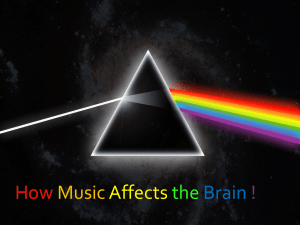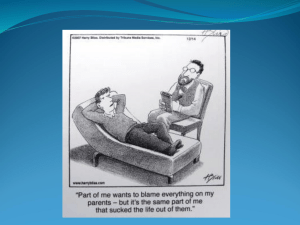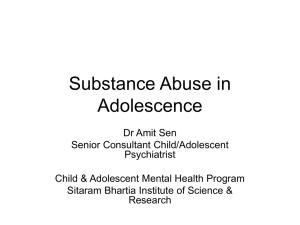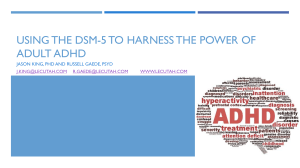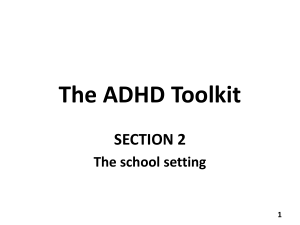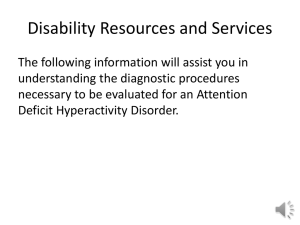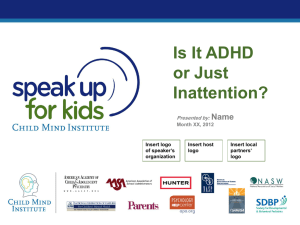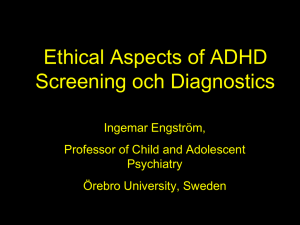Wiggly, Worried, Wierd, Warrior - Northwest Counseling and Guidance
advertisement
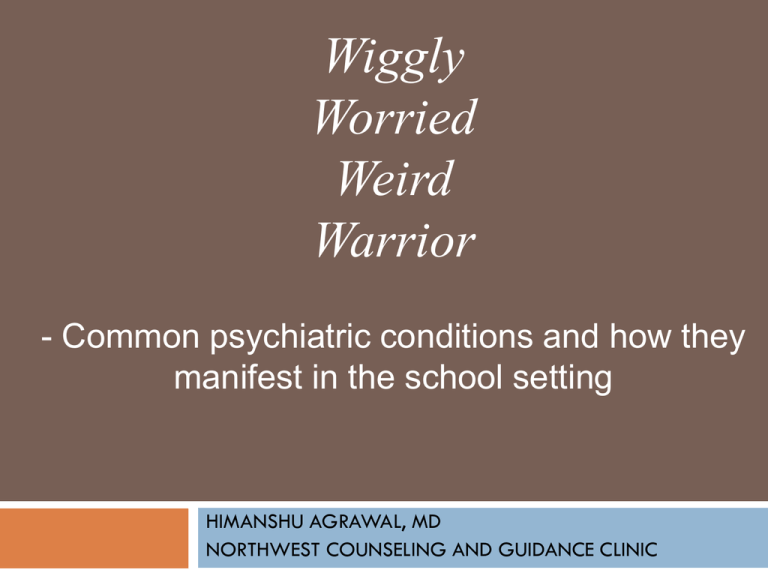
Wiggly Worried Weird Warrior - Common psychiatric conditions and how they manifest in the school setting HIMANSHU AGRAWAL, MD NORTHWEST COUNSELING AND GUIDANCE CLINIC Warm up Exercise 1. 2. Think about a student you know who is seeking mental health treatment Think about why he or she is seeking treatment Scratch these words out ADHD Depression Anxiety Oppositional Defiant Disorder Conduct disorder Autism Bipolar Instead…try one of these So that he can get along better with his teachers, parents, his friends So that he may have better grades So that she has fewer tantrums So that she cries less frequently So she hits others/herself less often So that he can get back on the football team again or enjoy choir more So that she stops thinking about suicide The Big 4 ADHD Depression Anxiety Anger Exercise 4 volunteers please! Signs of ADHD INATTENTION Careless mistakes Rushes through work Procrastinates to finish assignments Does the environment but forgets to turn it in Loses items (eraser, pencil etc) Desk/ Locker is disorganized/messy Day dreamer Needs to be told the same instruction multiple times Signs of ADHD HYPERACTIVITY AND IMPULSIVITY Excessively talkative Constantly fidgeting, constantly ‘on the go’ Running/ Climbing in inappropriate spaces Difficulty doing things quietly Difficulty waiting turn Blurts out answers when it is not his or her turn Interrupts others Myths about ADHD “I was the same way and the all I needed was a smack on the head !” http://www.twitvid.com/HUKCH “He doesn’t seem to have any problems concentrating on those #$@!! Video games !!!” “She doesn’t have ADHD, she’s just shy” “That child shouldn’t be on ADHD medshe’s already a peanut!” “That child shouldn’t be on ADHD medshe’s already a peanut!” Treatment with stimulants in childhood modestly reduced expected height and weight These effects attenuate over time Data suggest that ultimate adult growth parameters are not affected Deficits in height and weight do not appear to be a clinical concern for most children treated with stimulants Effect of stimulants on height and weight: a review of the literature.Faraone SV, Biederman J, Morley CP, Spencer TJ. J Am Acad Child Adolesc Psychiatry. 2008 Sep;47(9):994-1009. “Children become addicted to Ritalin if they take it for ADHD” “Children become addicted to Ritalin if they take it for ADHD” • The presence of ADHD may influence adolescent and adult substance-use disorders in different ways: • • • • earlier age of onset, higher frequency, longer duration of substance abuse and transition from alcohol-abuse to other substance-use disorders Attention-deficit/hyperactivity disorder and substance abuse Davids E, Gastpar M Comorbidity of alcohol and substance dependence with attention-deficit/hyperactivity disorder (ADHD) Ohlmeier MD, Peters K, Te Wildt BT, Zedler M, Ziegenbein M, Wiese B, Emrich HM, Schneider U. “Children become addicted to Ritalin if they take it for ADHD” • Children who take medication to treat attention deficit hyperactivity disorder (ADHD) face no greater risk of future substance abuse (13 year follow – up) – • Fischer et al, Pediatrics. 2003 Treatment with stimulant drugs may significantly decrease the risk that girls with ADHD will begin smoking cigarettes or using alcohol or drugs. – Wilens et al, Archives of Pediatrics and Adolescent Medicine Oct 2008. ADHD- Practical suggestions for the classroom DISTRACTIBILITY Seat the child away from doors and windows Alternate seated activities with those that allow the child to move his or her body around the room. Whenever possible, incorporate physical movement into lessons Write important information down where the child can easily read and reference it. Remind the student where the information can be found. Divide big assignments into smaller ones, and allow children frequent breaks. ADHD- Practical suggestions for the classroom IMPULSIVITY (Interruptive Children) Develop a “secret language” with the child to let the child know they are interrupting. Praise the child for interruption-free conversations. Write the schedule for the day on the board or on a piece of paper and cross off each item as it is completed. When necessary, give consequences immediately following misbehavior. Be specific in your explanation, making sure the child knows how they misbehaved ADHD- Practical suggestions for the classroom HYPERACTIVITY (Fidgetiness) Ask the child to run an errand or do a task for you, even if it just means walking across the room to sharpen pencils or put dishes away. Encourage the child to play a sport—or at least run around before and after school. Provide a stress ball, small toy, or other object for the child to squeeze or play with discreetly at his or her seat. Limit screen time in favor of time for movement. Make sure the child with ADD/ADHD never misses recess or P.E. ANXIETY & DEPRESSION Signs of Depression MOOD Sad Mad Loss of pleasure/ interest in activities Suicidal thoughts (including self injurious behaviors) Excessive risk taking (sense of foreshortened future) PERSPECTIVE Worthlessness (Self derogatory statements) Helplessness Hopelessness Inappropriate guilt Errors in Thinking Signs of Depression SLEEP Too little (insomnia) Too much (Hypersomnolence) WEIGHT Loss of appetite and weight Excessive weight gain Failure to reach appropriate weight for age Signs of Depression ENERGY CONCENTRATION Fatigue Social Isolation Psychomotor agitation (clenched fists et al!) Especially if this is a shift from baseline Sudden drop in grades VAGUE PHYSICAL COMPLAINTS Headaches Stomachaches Joints, back etc. Depression- Practical suggestions for the classroom Try and ask frequent questions about friends and family to show empathy and compassion. Try and accommodate tardiness and absences from school by providing study guides and make up work. Discourage bullying, teasing, and other undesirable behavior. Create a peace corner or safe area for a depressed student when his or her feelings erupt or become overwhelming. Try and break larger project into more manageable pieces for the student who has low energy. Provide an outlet for the child to express his or her feelings, such as a writing journal or an online diary. ANXIETY Bucket loads instead of spoonfuls! Signs of Anxiety EXCESSIVE WORRIES Multiple themes- safety, health, futures, career, taxes!! Perfectionist, inconsolable Strange Rituals Irritability Frequent headaches, stomachaches etc – ‘Worry self sick’ ‘Shy bladder’ Panic attacks Dissociation (zoning out/ going into trances) Get startled easily Nightmares Anxiety- Practical suggestions for the classroom Classroom seating should be away from classmates who are loud or misbehave If a large group activity is anticipated, warn the child ahead of time. If a change in routine is anticipated (e.g. substitute teacher), warn the child ahead of time. Always ask the child ahead of time if it is okay to call on them to participate, and tell her what she might expect during the activity. When anxious children are absent from school, they may be very distressed about the work they have missed. Assign a study buddy to copy notes and share handouts Anxiety- Practical suggestions for the classroom Instead of class presentations, give the child the option of presenting just to the teacher, or audio/video taping the presentation at home. Consider “lunch bunches” of 2-3 kids so they can create shared experiences. Don’t always allow children to choose their own group. Mistakes are OK, sometimes even encouraged and celebrated! Systematic desensitization(Baby steps!) Anger Anger Anger Atypical Antipsychotics Clonidine and Tenex Lithium Anti- Seizure medications If treatment is working… Calmer, less disruption , fewer outbursts Improved concentration, restlessness Improvement in irritability, behavioral problems Better Grades Fewer Time Outs Social Stundedness Autism Spectrum Abuse/ Trauma Schizophrenia The Big 4 ADHD Depression Anxiety Anger Thanks himanshua@nwpltd.org


